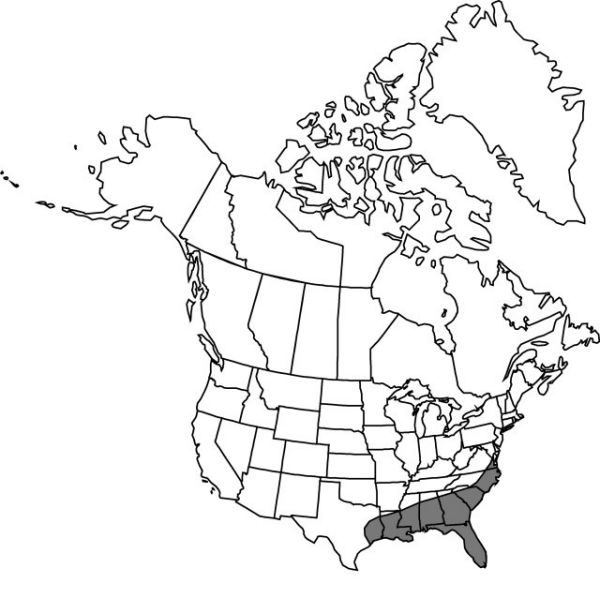Difference between revisions of "Ponthieva racemosa"
Contr. U.S. Natl. Herb. 6: 460. 1901.
FNA>Volume Importer |
imported>Volume Importer |
||
| (6 intermediate revisions by 2 users not shown) | |||
| Line 8: | Line 8: | ||
}} | }} | ||
|common_names=Shadow witch | |common_names=Shadow witch | ||
| − | |basionyms={{Treatment/ID/ | + | |special_status={{Treatment/ID/Special_status |
| + | |code=F | ||
| + | |label=Illustrated | ||
| + | }} | ||
| + | |basionyms={{Treatment/ID/Basionym | ||
|name=Arethusa racemosa | |name=Arethusa racemosa | ||
|authority=Walter | |authority=Walter | ||
| + | |rank=species | ||
| + | |publication_title=Fl. Carol., | ||
| + | |publication_place=222. 1788 | ||
}} | }} | ||
|synonyms={{Treatment/ID/Synonym | |synonyms={{Treatment/ID/Synonym | ||
|name=Neottia glandulosa | |name=Neottia glandulosa | ||
|authority=Sims | |authority=Sims | ||
| − | }}{{Treatment/ID/Synonym | + | |rank=species |
| + | }} {{Treatment/ID/Synonym | ||
|name=Ponthieva glandulosa | |name=Ponthieva glandulosa | ||
|authority=(Sims) R. Brown | |authority=(Sims) R. Brown | ||
| + | |rank=species | ||
}} | }} | ||
|hierarchy=Orchidaceae;Orchidaceae subfam. Orchidoideae;Orchidaceae tribe Cranichideae;Orchidaceae (tribe Cranichideae) subtribe Cranichidinae;Ponthieva;Ponthieva racemosa | |hierarchy=Orchidaceae;Orchidaceae subfam. Orchidoideae;Orchidaceae tribe Cranichideae;Orchidaceae (tribe Cranichideae) subtribe Cranichidinae;Ponthieva;Ponthieva racemosa | ||
| Line 33: | Line 42: | ||
|elevation=0–50 m | |elevation=0–50 m | ||
|distribution=Ala.;Fla.;Ga.;La.;Miss.;N.C.;S.C.;Tex.;Va.;Mexico;West Indies;Central America;South America. | |distribution=Ala.;Fla.;Ga.;La.;Miss.;N.C.;S.C.;Tex.;Va.;Mexico;West Indies;Central America;South America. | ||
| − | |discussion=<p>In Florida, Ponthieva racemosa is self-compatible but not autogamous. Natural fruit-set in one population in northern Florida was 35% (J. D. Ackerman 1995). In Florida, small halictid bees were observed visiting the flowers (C. A. Luer 1972).</p> | + | |discussion=<p>In Florida, <i>Ponthieva racemosa</i> is self-compatible but not autogamous. Natural fruit-set in one population in northern Florida was 35% (J. D. Ackerman 1995). In Florida, small halictid bees were observed visiting the flowers (C. A. Luer 1972).</p> |
|tables= | |tables= | ||
|references= | |references= | ||
| Line 42: | Line 51: | ||
-->{{#Taxon: | -->{{#Taxon: | ||
name=Ponthieva racemosa | name=Ponthieva racemosa | ||
| − | |||
|authority=(Walter) C. Mohr | |authority=(Walter) C. Mohr | ||
|rank=species | |rank=species | ||
| Line 56: | Line 64: | ||
|publication title=Contr. U.S. Natl. Herb. | |publication title=Contr. U.S. Natl. Herb. | ||
|publication year=1901 | |publication year=1901 | ||
| − | |special status= | + | |special status=Illustrated |
| − | |source xml=https:// | + | |source xml=https://bitbucket.org/aafc-mbb/fna-data-curation/src/2e0870ddd59836b60bcf96646a41e87ea5a5943a/coarse_grained_fna_xml/V26/V26_1117.xml |
|subfamily=Orchidaceae subfam. Orchidoideae | |subfamily=Orchidaceae subfam. Orchidoideae | ||
|tribe=Orchidaceae tribe Cranichideae | |tribe=Orchidaceae tribe Cranichideae | ||
Latest revision as of 22:11, 5 November 2020
Plants 30–60 cm. Roots 2–3 mm diam. Stems subterranean, short. Leaves green at anthesis, 2–6, subpetiolate; blade elliptic to oblanceolate, 5–17 × 2–5 cm, apex rounded to acute. Inflorescences: peduncle to 25 cm, partially enclosed by tubular sheaths, proximalmost sometimes leafy; rachis laxly 20–35-flowered, 5–25 cm; floral bracts narrowly lanceolate, clasping base of ovary, to 10 mm, apex acuminate, pubescent. Flowers: sepals greenish white, adaxially pubescent; dorsal sepal distinct, ovate-elliptic to elliptic-lanceolate, 4–7 × 2–3 mm, apex obtuse; lateral sepals broadly, obliquely ovate, 4.3–6.5 × 2.5–3.5 mm, apex acute to obtuse; petals white, green-veined, obliquely triangular, 4–6 × 3.5–5 mm, margins minutely ciliate or entire, glabrous; lip white with green, deeply concave center, distinctly clawed, suborbiculate, 5–7 × 5–7 mm, apex short-caudate; column white, 4–5 mm; pedicellate ovary 10–20 mm. Capsules 8–13 mm.
Phenology: Flowering fall–winter (Sep–Feb).
Habitat: Moist, shady hammocks, swamps, ravines, wet savannas, pine forests
Elevation: 0–50 m
Distribution

Ala., Fla., Ga., La., Miss., N.C., S.C., Tex., Va., Mexico, West Indies, Central America, South America.
Discussion
In Florida, Ponthieva racemosa is self-compatible but not autogamous. Natural fruit-set in one population in northern Florida was 35% (J. D. Ackerman 1995). In Florida, small halictid bees were observed visiting the flowers (C. A. Luer 1972).
Selected References
None.
